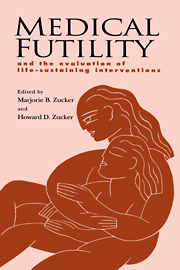Book contents
- Frontmatter
- Contents
- Preface
- Foreword
- Contributors
- 1 Medical futility: a useful concept?
- 2 Death with dignity?
- 3 Physicians and medical futility: experience in the critical care setting
- 4 Physicians and medical futility: experience in the setting of general medical care
- 5 Futility issues in pediatrics
- 6 Medical futility: a nursing home perspective
- 7 Alternative medicine and medical futility
- 8 How culture and religion affect attitudes toward medical futility
- 9 When religious beliefs and medical judgments conflict: civic polity and the social good
- 10 Conflict resolution: experience of consultation-liaison psychiatrists
- 11 Ethics committees and end-of-life decision making
- 12 The economics of futile interventions
- 13 Medical futility: a legal perspective
- 14 Professional and public community projects for developing medical futility guidelines
- 15 Community futility policies: the illusion of consensus?
- 16 Not quite the last word: scenarios and solutions
- Index of cited authors, cases, and statutes
- Subject index
8 - How culture and religion affect attitudes toward medical futility
Published online by Cambridge University Press: 11 September 2009
- Frontmatter
- Contents
- Preface
- Foreword
- Contributors
- 1 Medical futility: a useful concept?
- 2 Death with dignity?
- 3 Physicians and medical futility: experience in the critical care setting
- 4 Physicians and medical futility: experience in the setting of general medical care
- 5 Futility issues in pediatrics
- 6 Medical futility: a nursing home perspective
- 7 Alternative medicine and medical futility
- 8 How culture and religion affect attitudes toward medical futility
- 9 When religious beliefs and medical judgments conflict: civic polity and the social good
- 10 Conflict resolution: experience of consultation-liaison psychiatrists
- 11 Ethics committees and end-of-life decision making
- 12 The economics of futile interventions
- 13 Medical futility: a legal perspective
- 14 Professional and public community projects for developing medical futility guidelines
- 15 Community futility policies: the illusion of consensus?
- 16 Not quite the last word: scenarios and solutions
- Index of cited authors, cases, and statutes
- Subject index
Summary
Cultural and religious differences between the patient and the medical team are an underappreciated barrier to negotiating a sensitive and dignified process of dying for the patient. Medical professionals often have little understanding of their patients' views about health care decision making, life-sustaining technology, and the definitions of life and death (O'Rourke 1992). Impaired understanding because of cultural differences can make an already difficult struggle harder.
Cultures differ about definitions of life, death, and dying. For example, on the island of Vanatinai, southeast of Papua New Guinea, people are thought of as dead whom we would consider merely unconscious. Thus, it is possible for a person to die a number of times. On Vanatinai, considering someone to be dead generally leads to what we would consider medical neglect, but this disregard fits the cultural view (Rosenblatt 1993). In Hinduism, living is more than being alive, and quality of life plays an important part in the Hindu definition of life and death (Crawford 1995). Although brain death is a commonly accepted definition of death in the United States, Orthodox Jews do not accept it, and removing life support from a person who is brain dead is seen as tantamount to murder (Paris et al. 1995).
In times of crisis and when facing one's own mortality, religious and familial/cultural values are sources of strength and comfort. Recently, authors have disagreed about whether the Western emphasis on autonomy and full disclosure is respectful of dying patients with different cultural traditions.
- Type
- Chapter
- Information
- Medical FutilityAnd the Evaluation of Life-Sustaining Interventions, pp. 71 - 84Publisher: Cambridge University PressPrint publication year: 1997
- 2
- Cited by

